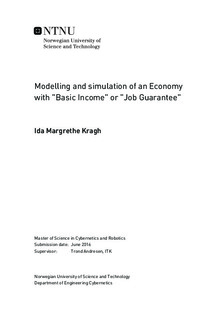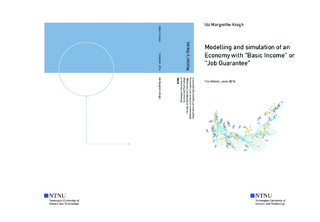| dc.description.abstract | In this report there has been designed a dynamic model of a country's economy using a stock-flow approach. The economy is hit by a great export crisis when the price of the country's main export product drops rapidly. As a result, unemployment is increasing and GDP is falling drastically.
The economy is modeled under three different regimes; Today's regime, the Job Guarantee (JG) regime, and a Basic Income (BI) regime. The alternative regimes are introduced to the model with the purpose to fight unemployment and support the struggling economy. All three models are simulated over a period of 6 years, to observe the effect on the economic dynamics from such a shock over time.
The JG is a governmental program that offers work to everyone, with the goal to reach full employment while keeping price stability. The JG wage will automatically become the minimum wage in the society, since everyone can get a job through the JG program, the JG wage is available for everyone. The JG program functions as a safety net for those that have lost their jobs in the private sector, but since it is paid at a minimum wage, people will move back to private employment when jobs are again available in the Private sector.
Modern Monetary Theory (MMT) is the foundation for the Job Guarantee. When JG is first introduced it will be an expensive program and money creation might be necessary, depending on the initial state of the economy. MMT claims that a sovereign government which holds its own currency can never run out of it, and can always afford to pay for what it wants to purchase. A government's goals should not be to avoid budget deficits, but to pursue full employment and price stability.
In the BI program, the government grant everyone an income that is high enough to cover basic needs such as housing, clothing and food. What makes the basic income scheme different from other minimum income schemes, is that the government gives everyone the same basic income on an individual basis in addition to any other income they may or may not have. The BI is also an expensive program and in the designed model it will be funded by three different methods; funding by taxation, money creation, and a mix of taxation and money creation.
The results of the simulations show that fewer people will lose their jobs in the private sector in both the JG regime and the BI regime, and that the money flow is higher than in the economy without the alternative regimes.
The export crisis has great impact on the economy. The GDP will suffer a drastic fall under both the JG regime and Today's regime, but with the JG the households' consumption is kept close to its original level, which suggests that the standard of living is close to its initial level.
The three ways of funding the Basic Income have given very different results. By funding the Basic Income with taxes, the economy will experience a drastic fall in GDP, while by funding it through money creation, the GDP will end up at the same level as it started and unemployment is only 6,5% compared to 20% in the Regular economy.
The export crisis causes net exports to fall below 0, which weakens the domestic currency. Under the JG regime and the BI regime funded by taxation the exchange rate ends up close to the exchange rate in the Regular model. While in the BI regime funded by money creation, the value of the domestic currency is reduced by 50%.
The BI regime funded by money creation will give the greatest economic growth, with regards to GDP, private employment and households saving and consumption, but by increasing the money supply, the government will have to take drastic measures to stabilize the prices.
It will be less challenging for the government to promote price stability under a JG regime. The JG regime also offers full employment, and it keeps households' spending power close to its initial level, and is therefore considered as the better choice by the two alternative regimes. | |

